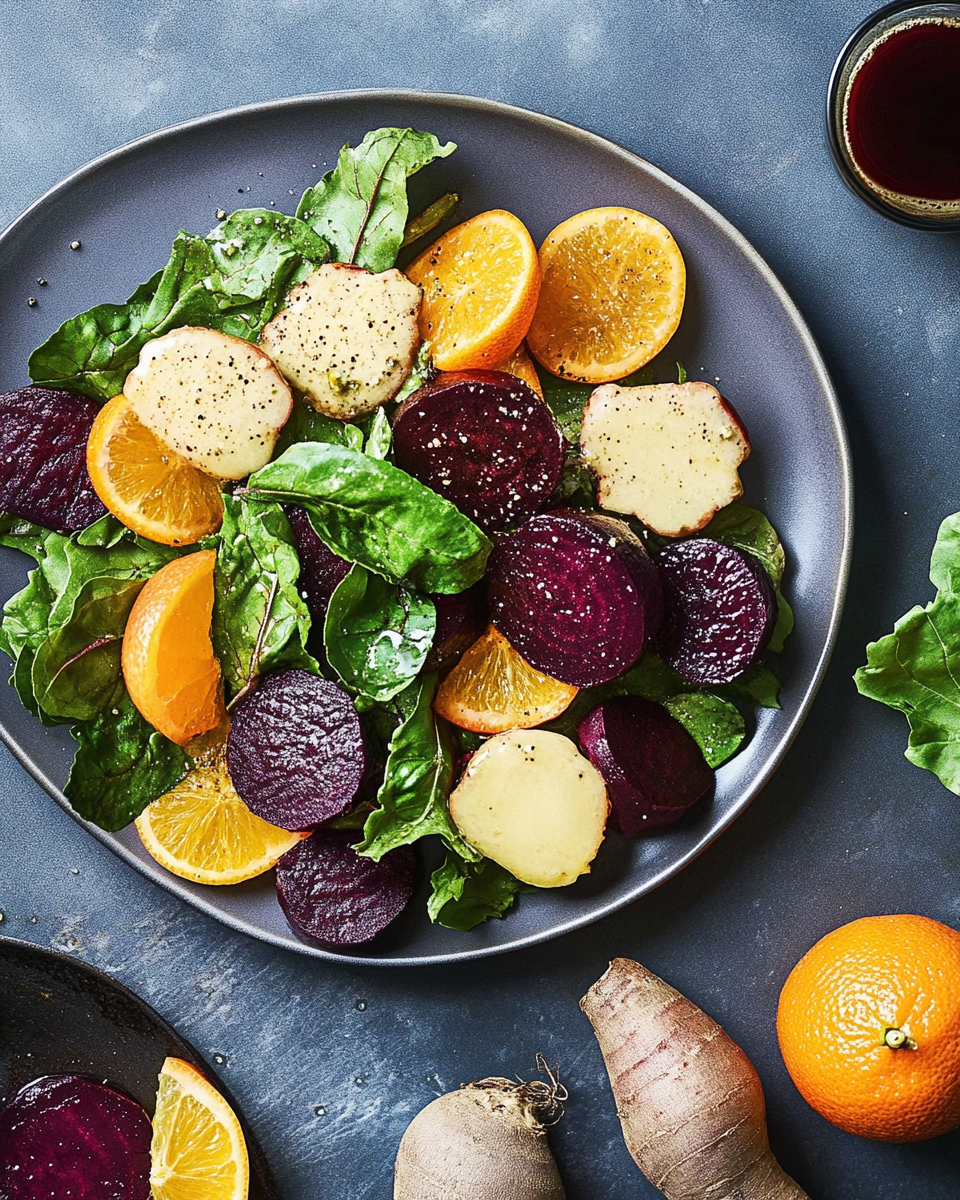This vibrant salad combines roasted beets, fresh citrus, and a tangy horseradish vinaigrette for a flavorful and refreshing dish. The sweetness of the beets pairs perfectly with the citrus’s acidity, while the horseradish adds a bold kick to the dressing.
FULL RECIPE
Ingredients
- 3 medium beets, peeled and cut into wedges
- 2 oranges, peeled and segmented
- 1 grapefruit, peeled and segmented
- 1 tablespoon olive oil
- Salt and pepper, to taste
- 2 tablespoons white wine vinegar
- 1 tablespoon Dijon mustard
- 1 teaspoon freshly grated horseradish
- 1/4 cup olive oil
- 1 tablespoon honey
- 2 cups mixed greens (such as arugula or spinach)
- 1/4 cup crumbled goat cheese (optional)
- 1/4 cup toasted walnuts (optional)
Directions
- Preheat the oven to 400°F (200°C).
- Toss the beet wedges in 1 tablespoon olive oil, salt, and pepper. Spread them out in a single layer on a baking sheet.
- Roast the beets for 25-30 minutes, or until tender, flipping halfway through.
- While the beets roast, prepare the vinaigrette. In a small bowl, whisk together the white wine vinegar, Dijon mustard, grated horseradish, honey, salt, and pepper.
- Slowly drizzle in 1/4 cup olive oil while whisking to create an emulsion.
- Once the beets are done, remove them from the oven and let them cool slightly.
- On a large serving plate, arrange the mixed greens. Top with roasted beets, orange, and grapefruit segments.
- Drizzle the horseradish vinaigrette over the salad.
- If desired, sprinkle with goat cheese and toasted walnuts for extra flavor and crunch.
- Serve immediately and enjoy!
Nutritional Information
- Calories: 200-250 per serving (depending on additions like goat cheese and walnuts)
- Protein: 3-4g
- Fat: 15-18g
- Carbohydrates: 25-30g
- Fiber: 5-7g
- Sugar: 15-18g (from the beets and citrus)
- Sodium: 200-300mg (depending on salt added)
Health Benefits of Roasted Beets
Beets are known for their health benefits, particularly their ability to improve heart health and reduce inflammation. Rich in fiber, beets support digestive health and may help lower cholesterol levels. The deep red color of the beetroot is a result of betalains, potent antioxidants that help detoxify the body and fight free radicals. Roasting enhances the natural sweetness of the beetroot, making it a flavorful addition to any salad.
Citrus Fruits and Their Nutritional Power
Citrus fruits, such as oranges and grapefruits, are excellent sources of vitamin C, a vital nutrient for boosting immunity and promoting skin health. Vitamin C also helps in the absorption of iron, making citrus an ideal pairing with beets, which are rich in iron. In addition to their vitamin C content, citrus fruits are loaded with fiber and antioxidants that contribute to digestive health and may help lower the risk of chronic diseases.
The Role of Horseradish in Flavor and Health
Horseradish is a pungent root vegetable that not only adds a unique flavor to the vinaigrette but also offers health benefits. It contains glucosinolates, which are compounds that can help detoxify the body and support the immune system. Horseradish is also known for its ability to aid digestion and relieve sinus congestion, thanks to its anti-inflammatory properties.
How Roasting Enhances the Flavor of Beets
Roasting beets brings out their natural sweetness and deepens their earthy flavor. Unlike boiling, which can dilute the flavor, roasting concentrates the beet’s sugars and enhances its taste. The caramelization process during roasting gives the beets a tender, melt-in-your-mouth texture, making them the perfect addition to a salad. It also intensifies the color, making the salad visually appealing.
Pairing Beets with Citrus for a Balanced Flavor
The sweetness of roasted beets pairs wonderfully with the bright, tart flavors of citrus fruits like oranges and grapefruits. This combination creates a balance of sweet, sour, and earthy notes that make each bite exciting. The acidity of the citrus fruits cuts through the richness of the beets, creating a refreshing contrast that elevates the overall dish.
The Importance of Olive Oil in the Vinaigrette
Olive oil is a staple in many salad dressings, and for good reason. It not only provides a rich, smooth base for the vinaigrette but also adds a dose of healthy monounsaturated fats. These fats are beneficial for heart health and can help lower bad cholesterol levels. Additionally, olive oil enhances the flavors of the other ingredients in the vinaigrette, creating a harmonious dressing that complements the earthy beets and bright citrus.
Vinegar in Salad Dressings: More Than Just Flavor
Vinegar is an essential component of most salad dressings, providing acidity that balances out the richness of oils and other fats. In this recipe, white wine vinegar is used for its mild and slightly fruity flavor. Beyond its role in flavor, vinegar has been linked to numerous health benefits, including stabilizing blood sugar levels and improving digestion. The tangy kick from the vinegar also helps to cut through the sweetness of the beets and citrus, creating a well-rounded vinaigrette.
Why Dijon Mustard Is the Perfect Choice for the Dressing
Dijon mustard adds a unique flavor profile to the vinaigrette. Its mild heat and tanginess help to tie the other ingredients together, creating a balanced dressing. Mustard also acts as an emulsifier, helping the oil and vinegar combine into a smooth, cohesive mixture. The addition of Dijon mustard to the dressing enhances the overall complexity of the flavors, giving the salad a sophisticated touch.
Honey as a Natural Sweetener
Honey is a natural sweetener that adds a subtle sweetness to the horseradish vinaigrette without overpowering the other flavors. Its mild, floral notes complement the earthiness of the beets and the tang of the citrus. In addition to enhancing flavor, honey has antibacterial properties and is a source of antioxidants, making it a healthier alternative to refined sugar in salad dressings.
The Versatility of Mixed Greens in Salads
Mixed greens, such as arugula, spinach, and baby kale, are the perfect base for this salad. These greens are not only packed with nutrients like vitamins A, C, and K, but they also add texture and freshness to the dish. Arugula, with its peppery bite, balances out the sweetness of the beets and the acidity of the citrus, while spinach provides a mild flavor that doesn’t overwhelm the other ingredients.
How to Choose the Best Beets for Roasting
When selecting beets for roasting, look for medium-sized, firm beets with smooth, unblemished skin. Smaller beets tend to be sweeter and more tender, while larger beets can sometimes be woody and fibrous. Choose beets with fresh, leafy greens attached, as this indicates that the beets are fresh. If the greens are wilted or yellowing, it may be a sign that the beets are past their prime.
Toasting Walnuts for Extra Crunch
Toasted walnuts add a delightful crunch and nutty flavor to this salad. The process of toasting enhances the natural oils in the walnuts, bringing out a richer, more robust flavor. Simply toast the walnuts in a dry skillet over medium heat for a few minutes, stirring frequently to prevent burning. Once toasted, allow them to cool before adding them to the salad for an added layer of texture.
The Benefits of Goat Cheese in Salads
Goat cheese, with its creamy and tangy flavor, is a perfect addition to this roasted beet and citrus salad. It adds richness and complexity to the dish while complementing the sweetness of the beets and the acidity of the citrus. Goat cheese is also lower in fat and calories compared to other cheeses, making it a healthier choice for those watching their calorie intake.
How to Prepare Citrus Segments
To prepare citrus segments, first cut off the top and bottom of the fruit to create a flat surface. Then, carefully slice away the peel and pith, ensuring you remove all the bitter white parts. Once peeled, use a sharp knife to cut along the membranes to release the individual segments. This technique helps create beautiful, bite-sized pieces that add color and juiciness to the salad.
Balancing Acidity and Sweetness in the Dressing
Creating a vinaigrette that balances acidity and sweetness is key to the success of this salad. The white wine vinegar provides the acidity needed to balance the richness of the olive oil, while the honey adds a natural sweetness that complements the beets and citrus. The horseradish adds an extra layer of sharpness, creating a complex and well-rounded dressing that enhances the overall flavor profile of the salad.
Serving Suggestions for Roasted Beet & Citrus Salad
This salad is perfect as a light lunch or as a side dish for dinner. It pairs beautifully with grilled meats, such as chicken or lamb, and can also be served alongside a creamy soup or pasta dish. For a more substantial meal, consider adding grilled chicken or tofu on top to increase the protein content. The salad can also be served as a starter at a dinner party, impressing guests with its vibrant colors and bold flavors.
Why This Salad Works for Different Dietary Preferences
This roasted beet and citrus salad is naturally vegetarian and gluten-free, making it a great choice for those with dietary restrictions. By omitting the goat cheese or walnuts, the salad can easily be made vegan, and it can be adapted to suit various dietary needs. The combination of fresh, whole ingredients ensures that the salad is both nutritious and satisfying, regardless of dietary preference.
Storage Tips for Leftover Salad
While this salad is best enjoyed fresh, you can store leftovers in an airtight container in the refrigerator for up to 2 days. To prevent the salad from becoming soggy, it’s a good idea to store the vinaigrette separately and toss it with the salad just before serving. The beets and citrus will keep their flavor and texture, but the greens may wilt after being dressed.
Adding More Flavor with Fresh Herbs
Fresh herbs, such as parsley, mint, or thyme, can elevate the flavor of this salad even further. Parsley adds a burst of freshness, while mint provides a cool contrast to the heat of the horseradish. Thyme, with its earthy undertones, complements the beets and can be added either to the vinaigrette or sprinkled on top as a garnish for added depth of flavor.
Perfect Pairings with Wine
The bright flavors of this roasted beet and citrus salad pair well with a variety of wines. A crisp, dry white wine, such as Sauvignon Blanc or Pinot Grigio, complements the acidity of the citrus and the earthiness of the beets. If you prefer red wine, a light-bodied option like Pinot Noir works well, as it won’t overwhelm the flavors of the salad. For those who enjoy rosé, a dry rosé will provide the right balance of fruitiness and acidity.
Conclusion
The Roasted Beet & Citrus Salad with Horseradish Vinaigrette is a perfect dish for anyone looking to enjoy a healthy, flavorful, and visually appealing salad. The combination of roasted beets, citrus fruits, and horseradish vinaigrette creates a harmonious blend of earthy, sweet, and tangy flavors. Whether served as a light lunch, a side dish, or a starter, this salad is sure to impress. Its versatility, vibrant colors, and health benefits make it a standout choice for any meal, and it’s easy to customize to suit various dietary needs and preferences. Enjoy this salad as a fresh, nutrient-packed addition to your next meal.






